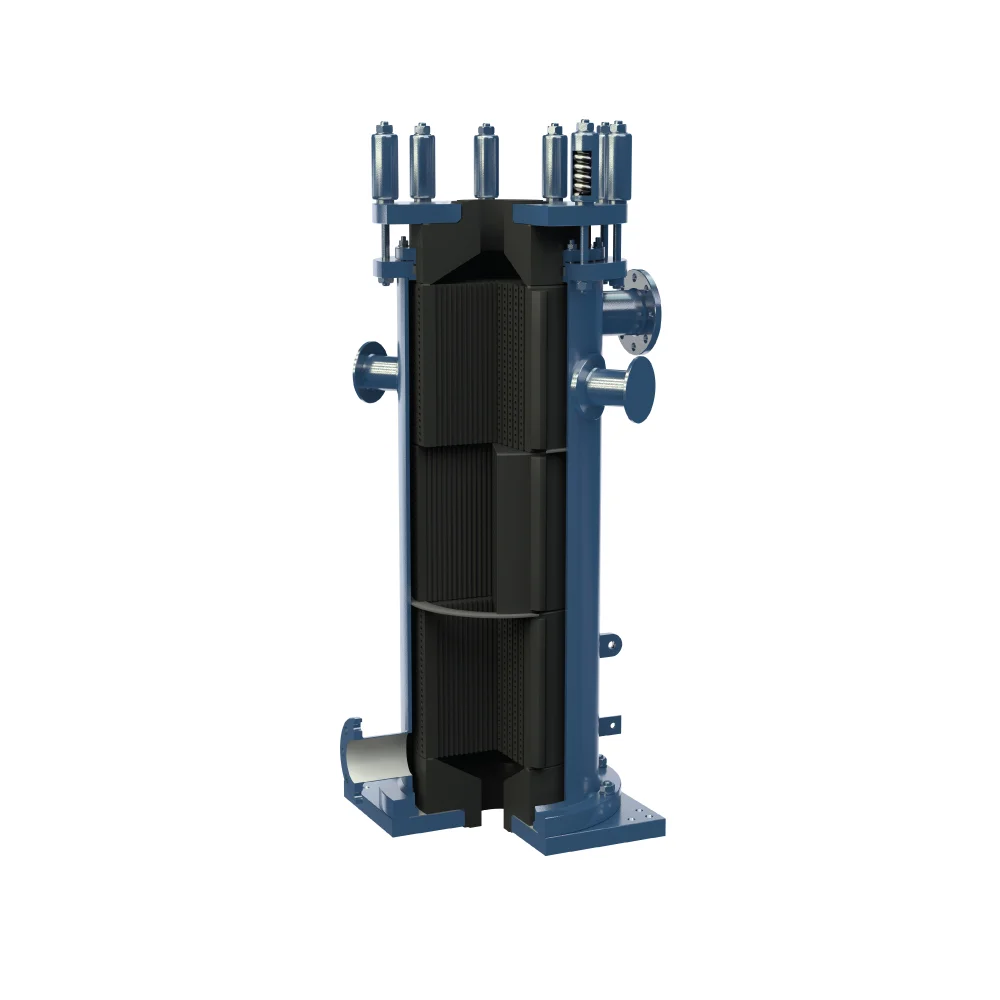Introduction
Graphite block heat exchangers is a device used to transfer heat between two fluids, typically when one or both are highly corrosive. Instead of using metal (which corrodes easily in acidic conditions), these heat exchangers use impervious graphite blocks—a material known for its exceptional corrosion resistance and high thermal conductivity. The blocks are precision-drilled with multiple flow passages, allowing two different fluids to flow through separate channels inside the same block. Heat is transferred through the graphite walls between these channels without mixing the fluids.
Construction and Design
Graphite block heat exchangers are designed in a modular format, and they consist of:
- Graphite Blocks: The core component is a block (or multiple blocks) of impervious graphite. These are engineered by impregnating natural graphite with resin to eliminate porosity, making it resistant to corrosive chemicals.
- Drilled Passages: Two sets of holes are drilled—one for the process fluid and one for the service fluid. The passages are arranged to allow cross-flow or counterflow configurations.
- Gaskets and Seals: High-grade chemical-resistant materials such as PTFE, graphite fiber, or fluoroelastomers are used to seal between blocks and prevent leakage.
- Steel Shell or Frame: The blocks are housed in a carbon steel or stainless steel frame to provide mechanical strength and protection against external impact.
- Tie Rods and Plates: These hold the entire structure under compression to prevent fluid bypass and ensure a tight seal.
This modular design makes it easy to expand, repair, or replace individual blocks without dismantling the entire unit.
Types of Graphite Block Heat Exchangers
➤ Cubic Block Type:
- These are block-shaped exchangers consisting of square or rectangular graphite units stacked together.
- Ideal for small to medium capacities.
- Easier to install and maintain due to the simpler shape.
➤ Cylindrical Block Type:
- Uses round graphite blocks.
- Suitable for vertical installation, often used in condensing or vertical cooling applications.
- May be preferred when flow distribution needs to be more symmetrical.
➤ Modular Block Design:
- Built using standardized blocks that can be added or removed to scale up or down.
- Allows for flexibility and easy replacement in case of partial damage.
Properties of Graphite Material
Graphite used in these exchangers is impervious, meaning it doesn’t allow fluids to pass through its pores.
- Thermal Conductivity: Graphite conducts heat very efficiently—on par with some metals—enabling effective heat transfer even with compact size.
- Corrosion Resistance: It withstands strong acids like hydrochloric acid (HCl), sulfuric acid (H₂SO₄), hydrofluoric acid (HF), and others, making it ideal for aggressive chemical applications.
- Non-Metallic: It does not release metal ions, which is important in high-purity processes where contamination must be avoided (e.g., pharmaceuticals).
- Brittle Nature: Although strong in compression, graphite is brittle and must be protected from impact or vibration.
Advantages
Corrosion Resistance:
- Graphite’s non-metallic nature allows it to resist even the most aggressive chemicals where metals would corrode.
- Useful in processing acids and halogen compounds.
High Thermal Efficiency:
- The natural thermal conductivity of graphite enables rapid and efficient heat transfer between fluids.
Ease of Maintenance:
- The modular structure means only damaged blocks need to be replaced, rather than the entire unit.
- Cleaning is also easier as sections can be disassembled.
Space Saving:
- Compact block arrangement allows a lot of surface area in a small footprint.
- Good for plants with space constraints.
Non-Contaminating:
- Does not leach or introduce impurities into the product, critical for pharmaceutical and food-grade applications.
Limitations
Brittle and Fragile:
- Graphite is mechanically weak compared to metals.
- Must be handled carefully to avoid cracking or damage during installation or operation.
Limited Temperature Range:
- While graphite can tolerate high temperatures, the resin used to make it impervious usually limits the operational temperature (typically up to 200–220°C).
Low Pressure Tolerance:
- Suitable for operations under low to moderate pressures (generally < 7 bar), which may not be sufficient for all processes.
Initial Cost:
- Manufacturing precision blocks and assembling them into exchangers costs more than standard metal units.
- However, long-term savings from corrosion resistance may outweigh this.
Conclusion
Graphite block heat exchangers are a highly efficient and corrosion-resistant solution for heat transfer in aggressive chemical environments. Their modular design, excellent thermal conductivity, and compatibility with highly corrosive fluids like strong acids make them ideal for industries such as pharmaceuticals, chemical processing, fertilizers, and steel pickling. While they do have limitations in terms of mechanical strength and operating pressure, their ability to withstand harsh conditions without degradation provides long-term reliability and lower maintenance needs. When selected and handled properly, graphite block heat exchangers offer a cost-effective and durable alternative to traditional metallic exchangers in corrosive service conditions.

